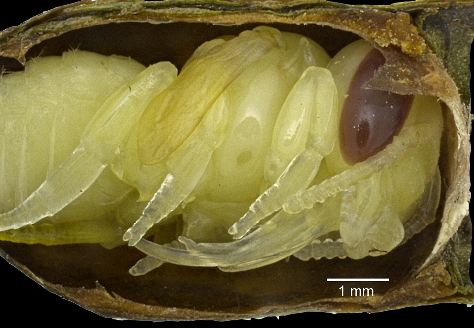Please note: Osher Rainforest will be closed for maintenance Jan. 14–16.
Science News
Small Buggy Fossils
April 14, 2014
by Molly Michelson

A 305-million-year-old daddy-longleg fossil made news last week when a team of scientists discovered the arthropod had a hidden set of eyes. Daddy longlegs, actually called harvestmen, aren’t what you’d expect says Russell Garwood, of the University of Manchester. “Although they have eight legs, harvestmen are not spiders; they are more closely related to another arachnid, the scorpion.” You can see the difference in the eyes: spiders have six or more, while modern-day harvestmen have only two.
However, this fossil possesses another set of eyes—the usual median eyes—those found near the center of the body – and lateral eyes on the side of the body as well. According to Prashant Sharma, of the American Museum of Natural History, the find could reveal important clues about arthropod evolution. “This exceptional fossil has given us a rare and detailed look at the anatomy of harvestmen that lived hundreds of millions of years ago… Terrestrial arthropods like harvestmen have a sparse fossil record because their exoskeletons don't preserve well. As a result, some fundamental questions in the evolutionary history of these organisms remain unsolved.”
The study is in Current Biology.
Then, fast-forwarding several hundred million years, another fossil swarming the science news pages last week: leafcutter bees discovered among the saber-tooth cats and mammoths in the La Brea Tar Pits.
The fossils are actually the bees’ nests and pupae, between 35,000 and 40,000 years old, and belong to Megachile gentilis, a species still alive today. ScienceShot explains leafcutter bees’ name: “so-called because the female insect constructs the nests out of leaf fragments glued together with saliva and leaf sap.”
These fossilized insect nests are a treasure trove, according to researcher Anna R. Holden of the Natural History Museum of Los Angeles County. “Because this is a fossil of rare life-stage, it’s an exceptional find in itself,” Holden says. “But it’s just the tip of the iceberg, we know that insects offer a vivid portrait of the prehistoric conditions of this area, and there are literally thousands more to study… Insects often serve as important paleoecological indicators…”
The fossils not only tell the scientists about climate at the time—moderate, since that is what the bees can tolerate now—and the vegetation. The nests were found to contain leaves of flowering plants and “infer a wooded or riparian habitat with sufficient pollen sources for larval provisions,” according to the study, published in PLoS ONE.
Sometimes the tiniest fossils provide the largest clues!
Image: Leafcutter bee, A.R. Holden et al./PLOS ONE